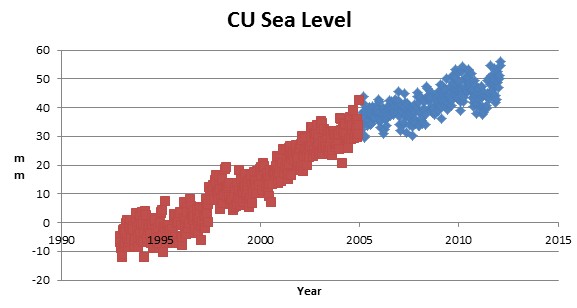sealevel.colorado.edu/files/2012_rel2/sl_ns_global.txt
From 1992 through 2004, sea level rose at 3.55 mm/year, according to the University of Colorado. From 2005 to 2012, the same data set shows 1.81 mm/year. If sea level continues to rise at the current rate, we will see sixteen centimeters of sea level rise by the end of the century, which is perhaps one tenth of what the experts are claiming this week.
Government funded global warming research is propaganda. It has nothing to do with science.
—————————————————————————————
Ed Caryl informs me that he covered this same topic last week in more detail.
http://notrickszone.com/2012/06/18/data-show-sea-level-rise-has-slowed-down-over-the-last-7-years/



I expect they will blame the discrepancy over the last 7 years on ENSO.
How many big el ninos has hansen forecast since 2007?
Trick question? 😉
He forecast 2 super El Nino’s. One for 2009 and one for 2011, give or take two. The second one was actually a La Nina.
At this rate, Al Gore’s famous “20 feet” of sea level rise will take 3315 years to happen.
Thank you, Stephen.
http://notrickszone.com/2012/06/18/data-show-sea-level-rise-has-slowed-down-over-the-last-7-years/
Sorry Ed, I didn’t see your article. I will add a link
Always good to archive these things…
http://www.webcitation.org/68fta3STH
another rising sea level threatens Manhattan story:
http://news.yahoo.com/rising-sea-level-puts-us-atlantic-coast-risk-171554622.html
Cherry picking if ever there was any, BUT, the entire data satellite data set shows a negative acceleration of minus 0.06 mm/yr² as this screen shot
http://i39.tinypic.com/nr14bq.jpg
from this CU presentation
Why has an acceleration of sea level rise not been observed during the altimeter era?
Link:
http://www.aviso.oceanobs.com/fileadmin/documents/OSTST/2011/oral/02_Thursday/Splinter%203%20SCI/04%20Nerem%20ostst_2011_nerem.pdf
shows.
What’s fun is to plot out what happens if that negative acceleration continues. Looks like this:
http://i48.tinypic.com/2saytc4.jpg
In no way am I predicting that sea level will fall 300 mm by 2100 but I am saying that there is no evidence that the opposite is going to occur.
It isn’t cherry picking. There is a clear break in the slope at 2005.
Haven’t we been saying this for years? The narrative is false. Period.
Northern Hemisphere warming, yes. Until 1998. Southern? And a much larger water content. It is cooling!
Serious question: when is thermal expansion supposed to kick in? After all we have had 30 years of terrible global warming with the ‘hottest decade on the record’.
The heat is still hiding at the bottom of the sea
But wait a moment, here. Did we not read this?
From the LATimes yesterday: 1.00 from 2 ratings
USGS: Sea level in Atlantic ‘hot spot’ rising faster than world’s
http://www.latimes.com/news/nation/nationnow/la-na-nn-sea-level-atlantic-20120625,0,5813153.story
A choice excerpt:
The USGS report follows a study by the National Research Council predicting that sea levels along the California coast will rise as much as one foot in just 20 years, two feet by 2050 and five-and-a-half feet by 2100. The report, released Friday, says the increases are caused by climate change and by the sinking of land masses in much of California.
The study predicts that global sea levels will rise 9 inches by 2030, 18 inches by 2050, and four-and-a-half feet by 2100.
On the other hand, here’s NOAA’s record for Los Angeles, CA
http://tidesandcurrents.noaa.gov/sltrends/sltrends_station.shtml?stnid=9410660
Hmm – wake me up when it begins. . .
RealClimate today reports on SLR estimates for 2300, a nice after-retirement date, that have a MINIMUM of 1.0m by 2100. Even at 3.5 mm/yr, that is only 0.31m by 2100. The tripling of a current rate to get to the minimum seems of no issue. It must start soon, must it not?
Schmidt has no conscience. He has no ability to be embarrassed. If the Climate Wars were a Criminal Minds show, Schmidt would play the business executive sociopath in the next-door office who is undisturbed by anything as long as he gets his way.
If he finds this insulting, then I’ll apologize – as soon as he says when the SLR is going to begin rocketing up (along with the temperatures, droughts, storms, mid-tropospheric hotspot etc.).